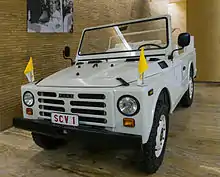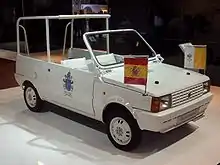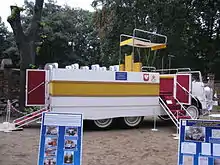Popemobile
The popemobile is a specially designed motor vehicle used by the pope of the Catholic Church during public appearances.[1] It is considered a successor to the sedia gestatoria and was designed to allow the pope to be more visible when greeting large crowds.
.jpg.webp)
There have been many different designs for popemobiles since Pope Paul VI first used a modified Lincoln Continental to greet crowds in New York City in 1965. Some are open air, while others have bulletproof glass walls to enclose the pope, deemed necessary after the 1981 assassination attempt of Pope John Paul II. Some allow the pope to sit, while others are designed to accommodate him standing. The variety of popemobiles allows the Roman Curia to select an appropriate one for each usage depending upon the level of security needed, distance, speed of travel, and the pope's preferences.
The vehicle registration plates of Vatican City all begin with the letters "SCV", an abbreviation of the Latin Status Civitatis Vaticanae ("Vatican City State"), followed by the vehicle fleet number. The registration plate for the Ford Focus currently used by Pope Francis is "SCV 00919".[2] In the past, the popemobile has typically used registration plate "SCV 1", although plates numbered "SCV 2" to "SCV 9" have also been used.[3]
History





The precursor to the popemobile was the sedia gestatoria, a chair carried on the shoulders of papal attendants. This fell out of use after the death of Pope Paul VI in 1978. Pope John Paul I, who succeeded Pope Paul VI and reigned for only 33 days before his death, was the last pope who used the sedia gestatoria.[4]
The first time that John Paul II traveled to his home country, the white vehicle was based on the Polish mark FSC Star, a small truck from a firm in Starachowice. For John Paul II's visit to Ireland in 1979, Ford Ireland donated a D series truck which was adapted by OBAM coachbuilders; in 2017 it was available for private rental in Dublin.[5] It was bigger than the truck used later in Vatican City. Another popemobile was a modified Mercedes-Benz with a small windowed enclosure in the back where the pope sits. A converted 230 G Mercedes-Benz G-Class was built for John Paul II's visit to Germany in 1980.[6]
Following the attempted assassination of John Paul II in 1981, the popemobile was fitted with bulletproof glass. British Leyland supplied both Leyland T45 lorry-based and Range Rover SUV-based armored popemobiles in 1982 for the pope's visit to the United Kingdom. One of the two T45-based vehicles used was sold at auction in 2006 for 37,000 GBP, the other is kept in the British Commercial Vehicle Museum in Leyland, UK.[7] One of the Range Rovers is exhibited at the National Museum of Funeral History (Houston, Texas).[8] The pope used a popemobile derived from the SEAT Panda model during his visit to Spain in 1982; this specific car was open-air with a grab handle in front so that the pope could stand still and greet the crowds while moving.[9] The pope entered the Camp Nou football stadium in Barcelona,[10] driving through the assembled crowds celebrating Mass for a congregation of over 121,000 on 17 November 1982.
During the pope's visit to Canada in 1984, a modified GMC Sierra was used as a base, rebuilt by the Thibault Fire Engines Company in Pierreville, Quebec. It was subsequently used for the 1998 papal visit to Cuba and was displayed at the Canada Science and Technology Museum in Ottawa in 2005. The second truck built by the Thibault Fire Engines Company[11] was sent back to the Vatican in 1984.[12]
During the papal visit to the United States in September 1987, a pair of Mercedes-Benz 230 G popemobiles were flown to Washington, D.C., and modified by the United States Secret Service to provide access to the papal compartment from the driver's cabin, a design that continued to be used after the trip.[13] One of these vehicles has been retired and is currently on display at the Mercedes-Benz Museum in Stuttgart, Germany.
In 2002, John Paul II requested that the media stop referring to the popemobile as the "popemobile", saying that the term was "undignified".[1] The popemobile most often used by Pope Benedict XVI when traveling abroad was a modified Mercedes-Benz M-Class sport utility vehicle with a special glass-enclosed room that had its own oxygen supply built into the back of the vehicle. The pope enters through a rear door and ascends several steps. He then sits in a chair made from white leather with gold trim which is then elevated into the glass room by a hydraulic lift, allowing the pope to be more easily seen. In addition to the driver, there is room for one passenger (usually a security agent) in the front of the vehicle. The glass-enclosed rear of the vehicle also has room for two papal aides who can sit in the area in front of the pope's elevated chair. The vehicle's security features include bulletproof glass windows and roof, able to withstand explosions, and reinforced, armored side panels and undercarriage designed to resist bomb blasts. At 2011 prices, the popemobile cost approximately 345,000 GBP.[14]
On June 6, 2007, a German man tried to jump into Benedict XVI's uncovered popemobile as the pontiff began his general audience. The pope was not hurt and did not even appear to notice that the man had jumped over the protective barrier in the square and had grabbed onto the white Fiat popemobile as it passed. At least eight security officers were trailing the vehicle as it moved slowly through the square. They subsequently grabbed the man and wrestled him to the ground, before he was interrogated by Vatican police.[15]
Usage by Francis
.jpg.webp)
Pope Francis shows a preference for a simpler lifestyle and simpler cars. As a cardinal, he often used public transport.[16] On the night of his election, he rode with the other cardinals in a minibus back to their hotel instead of using a papal limousine.[17] For trips within the Vatican City, he uses a small Ford Focus from the Vatican motor pool. He also drives himself around the city in a 1984 Renault 4 presented to him by Italian Father Renzo Zocca.[18]
A Kia Soul was used as the Popemobile in August 2014 when he visited South Korea.[19]
Italian automaker Fiat, the traditional supplier of papal cars, supplied Pope Francis with the Fiat 500L used for his visit to the United States on 22–27 September 2015.[20] Fiat also supplied the Jeep Wrangler he used in Ecuador in July 2015.[21]
During his visit in the Philippines, the Popemobile's model was an Isuzu D-Max.[22] In 2019, Pope Francis received a Dacia Duster to be used as the popemobile during his visit to Romania.[23]
References
- Daniel Stone (April 14, 2008). "A Peek Inside the Popemobile". Newsweek. Retrieved September 21, 2010.
- "Pope Francis uses Ford Focus". blogspot.com. 16 September 2013. Retrieved 25 December 2013.
- Guglielmo Evangelista. "LE TARGHE E I VEICOLI DELLA CITTÁ DEL VATICANO" (PDF) (in Italian). Retrieved May 7, 2013.
- The last days of Johannes Paulus I (Albino Luciani 1978) (Television production) (in Italian). Retrieved 24 April 2014.
- Sheridan, Colette (5 June 2017). "The Popemobile used during his visit to Ireland can now be hired for Stags and Hens". Irish Examiner. Retrieved 4 October 2021.
- Mercedes-Benz Museum – section C4 Gallery of Celebrities – 1980 230 G Popemobile
- "Popemobile goes up for auction". The Times. 21 July 2006. Retrieved 12 February 2021.
- "Yes, Houston is Home to the National Museum of Funeral History". Houstonia. 30 June 2016. Retrieved 15 June 2021.
- The Evolution Of The Popemobile Jalopnik, September 26, 2008
- Where JFK meets the Queen and Khrushchev Audi USA News, March 4, 2008
- 'Popemobile' Plush, Impervious Thibault Fire Engines
- Canadian Popemobile going on display CBC News, April 7, 2005
- Petro, Joseph (2005). Standing Next To History. pp. 224–225. ISBN 0-312-33221-1.
- Day, Matthew. "Popemobile to go green". The Telegraph. Telegraph Media Group Limited. Archived from the original on June 24, 2011. Retrieved 14 February 2013.
- Man tries to breach Benedict XVI security The Times of India, 6 June 2007
- Fisher, Max (2013-03-13). "New pope, Jorge Mario Bergoglio, rode the bus because he gave up his limo". The Washington Post. Retrieved 2021-08-17.
- Zwartz, Barney (2013-03-14). "Pope Francis' spontaneous first steps". The Sydney Morning Herald. Retrieved 2021-08-17.
- "Pope Francis to drive his own popemobil inside Vatican City"
- Seoul, Associated Press in (2014-08-14). "Pope Francis makes big impression with small car in South Korea". the Guardian. Retrieved 2022-09-19.
- Peralta, Eyder (2015-09-25). "The Pope, His Black Fiat And The Symbolism Behind It". NPR.org. Retrieved 2021-08-17.
- Linkhorn, Tyler (2015-08-22). "Pope to ride in Jeep Wrangler". The Blade. Retrieved 2021-08-17.
- "Higher Horsepower - An Illustrated 215-year History of the Popemobile". The Washington Post. September 2015.
- "Pope Francis receives exclusive Dacia Duster as new Popemobile". Romania Insider. 29 November 2019. Retrieved 2020-05-13.